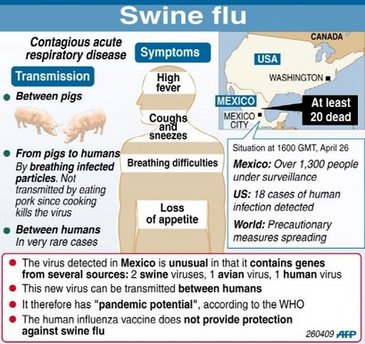 |
| Factfile on the swine flu outbreak that started in Mexico.[Agencies] |
WASHINGTON – The world's governments raced to avoid both a pandemic and global hysteria Sunday as more possible swine flu cases surfaced from Canada to New Zealand and the United States declared a public health emergency. "It's not a time to panic," the White House said.
Mexico, the outbreak's epicenter with up to 86 suspected deaths, canceled some church services and closed markets and restaurants. Few people ventured onto the streets, and some wore face masks. Canada became the third country to confirm cases, in six people, including some students who — like some New York City spring-breakers — got mildly ill in Mexico. Countries across Asia promised to quarantine feverish travelers returning from flu-affected areas.
The U.S. declared the health emergency so it could ship roughly 12 million doses of flu-fighting medications from a federal stockpile to states in case they eventually need them — although, with 20 confirmed cases of people recovering easily, they don't appear to for now.
Make no mistake: There is not a global pandemic — at least not yet. It's not clear how many people truly have this particular strain, or why all countries but Mexico are seeing mild disease. Nor is it clear if the new virus spreads easily, one milestone that distinguishes a bad flu from a global crisis. But waiting to take protective steps until after a pandemic is declared would be too late.
"We do think this will continue to spread but we are taking aggressive actions to minimize the impact on people's health," said Dr. Richard Besser, acting chief of the Centers for Disease Control and Prevention.
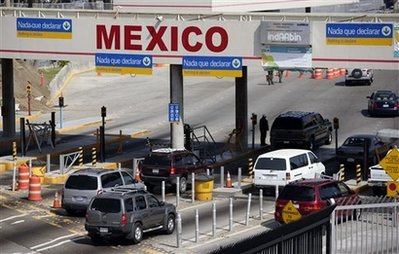
Vehicle traffic crosses from the U.S. into Mexico at the San Ysidro Port of Entry in San Diego Sunday, April, 26, 2009. [Agencies]
President Barack Obama's administration sought to look both calm and in command, striking a balance between informing Americans without panicking them. Obama himself was playing golf while U.S. officials used a White House news conference to compare the emergency declaration with preparing for an approaching hurricane."Really, that's what we're doing right now. We're preparing in an environment where we really don't know ultimately what the size or seriousness of this outbreak is going to be," Homeland Security Secretary Janet Napolitano told reporters.
Earlier, White House press secretary Robert Gibbs said the outbreak was serious, but that the public should know "it's not a time to panic." He told NBC's "Meet the Press" that Obama was getting updates "every few hours" on the situation.In Mexico, soldiers handed out 6 million surgical-style masks to deal with a deadly flu strain that officials say may have sickened 1,400 people since April 13. Special laboratory tests to confirm how many died from it — 22 have been confirmed so far out of 86 suspected deaths — are taking time.
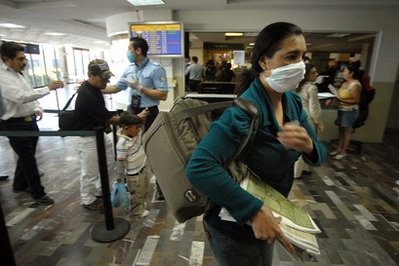
A woman leaves an immigration post wearing a mask as a preventive measure against infection from swine flu, in Tijuana airport.[Agencies]
The World Bank said it would send Mexico $25 million in loans for immediate aid and $180 million in long-term assistance to address the outbreak, along with advice on how other nations have dealt with similar crises.
The World Health Organization and the U.S. were following a playbook of precautions developed over the past five years to prepare for the next super-flu. The WHO on Saturday asked all countries to step up detection of this strain of A/H1N1 swine flu and will reconsider on Tuesday whether to raise the pandemic threat level, in turn triggering additional actions.
A potential pandemic virus is defined, among other things, as a novel strain that's not easily treated. This new strain can be treated with Tamiflu and Relenza, but not two older flu drugs. Also, the WHO wants to know if it's easily spread from one person to a second who then spreads it again — something U.S. officials suspect and are investigating.
"Right now we have cases occurring in a couple of different countries and in multiple locations, but we also know that in the modern world that cases can simply move around from single locations and not really become established," cautioned WHO flu chief Dr. Keiji Fukuda.
There is no vaccine against swine flu, but the CDC has taken the initial step necessary for producing one — creating a seed stock of the virus — should authorities decide that's necessary. Last winter's flu shot offers no cross-protection to the new virus, although it's possible that older people exposed to various Type A flu strains in the past may have some immunity, CDC officials said Sunday.
Worldwide, attention focused sharply on travelers.
"It was acquired in Mexico, brought home and spread," Nova Scotia's chief public health officer, Dr. Robert Strang, said of Canada's first four confirmed cases, in student travelers.

A view of the empty Azteca stadium during the Mexican league soccer match between America and Tecos in Mexico City April 26, 2009. [Agencies]
New Zealand said 10 students who took a school trip to Mexico probably had swine flu, and on Monday it said three students in a second group just back from Mexico probably have it as well. Spanish authorities had seven suspected cases under observation. In Brazil, a hospital said a patient who arrived from Mexico was hospitalized with some swine flu symptoms. A New York City school where eight cases are confirmed will be closed Monday and Tuesday.
China, Russia and Taiwan began planning to quarantine travelers arriving from flu-affected areas if they have symptoms. Italy, Poland and Venezuela advised citizens to postpone travel to affected parts of Mexico and the U.S.
Multiple airlines, including American, United, Continental, US Airways, Mexicana and Air Canada, are waiving their usual penalties for changing reservations for anyone traveling to, from or through Mexico, but have not canceled flights.
The U.S. hasn't advised against travel to Mexico but does urge precautions such as frequent hand-washing while there, and has begun questioning arriving travelers about flu symptoms.
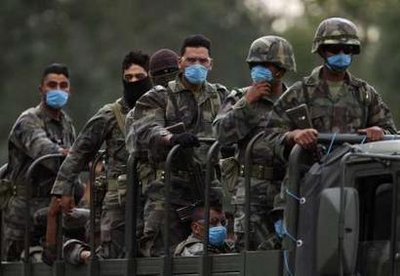
Mexican soldiers wear surgical face masks as they stand on an Army vehicle in Mexico City April 26, 2009.[Agencies]
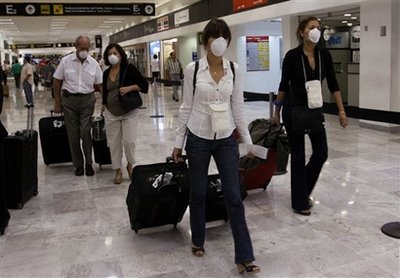
Passengers, wearing surgical masks as a precaution against infection, arrive at the airport in Mexico City, Sunday, April 26, 2009.[Agencies]
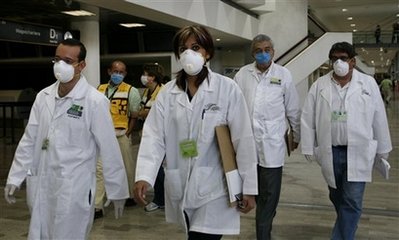
Health workers wearing surgical masks as a precaution against infection are seen at the airport in Mexico City, Sunday, April 26, 2009.[Agencies]
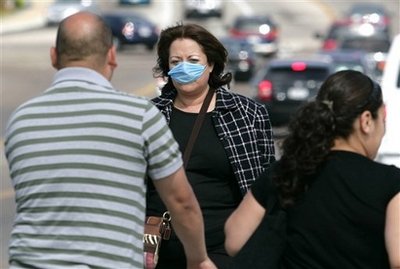
Jarrita Juarez, center, wears a mask after entering the U.S. from Mexico at the San Ysidro Port of Entry in San Diego Sunday, April, 26, 2009.[Agencies]
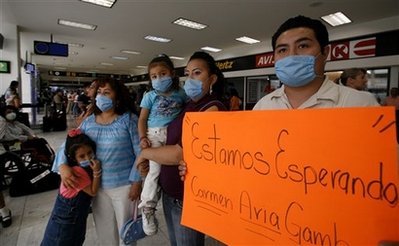
A family wearing surgical masks to prevent infection wait for a relative to arrive at the airport in Mexico City, Sunday, April 26, 2009.[Agencies]
taken from : China Daily



No comments:
Post a Comment